Impressed Action Marks
Impressed action
marks, with a few exceptions, are produced when a cartridge
case is fired in a firearm. The two most common impressed action
marks are firing pin impressions and breech marks.
As mentioned at the end of the Striated Action Marks page, ejector
marks can also be in the form of an impressed action mark.
Firing
pin impressions are indentations created when the firing pin of a
firearm strikes the primer of centerfire cartridge case or the rim of
a rimfire cartridge case. If the nose of the firing pin has
manufacturing imperfections or damage, these potentially unique
characteristics can be impressed into the metal of the primer or rim
of the cartridge case.
The
comparison image below shows the firing pin impressions on two
centerfire cartridge cases. As you can see, the firing pin
impressions have both circular manufacturing marks and parallel marks
from a defect in the nose of the firing pin.
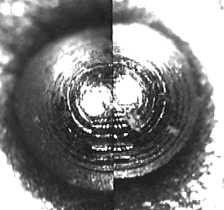
The
comparison image below shows firing pin impressions on two rimfire
cartridge cases. Imperfections in the surface of the nose of the
firing pin consistently produced these impressed marks.
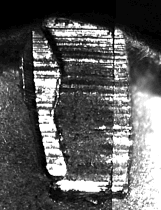
Firing pin
impressions also can be found on live cartridges. One of those few
exceptions I mentioned earlier. In some cases, the firing pin may miss the
primer of a cartridge or fail to strike the primer of a cartridge with
sufficient force for it to discharge. The cartridge may also misfire due
to a contaminated or deteriorated primer compound. For whatever reason,
the result will be the presence of a firing pin impression on the cartridge case
of a live cartridge. This could be significant if the cartridge is say,
left at the scene or found at a suspect's house. The comparison image
below shows light firing pin impressions on an evidence cartridge case (left)
and a test standard from a suspected firearm (right).

By far the most
common impressed action marks on cartridge cases are breech marks.
Most fired cartridge cases are identified as having been fired by a specific
firearm through the identification of breech marks.
Very high
pressures are generated within a firearm when a cartridge is discharged. These pressures
force the bullet from the cartridge case and down the barrel at very high
velocities. When a firearm is discharged, the shooter will feel the firearm
jump rearward. This rearward movement of the firearm is called recoil.
Recoil is for the most part caused by the cartridge case moving
rearward as an opposite reaction to the pressures generated to
force the bullet down the barrel.
When the head or
base of the cartridge case moves rearward, it strikes what is called the breech
face of the firearm. The image below shows the breech face of a 12
GAUGE, single-shot shotgun.
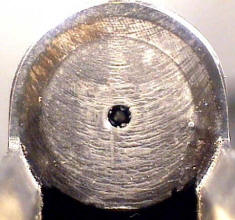
The breech face
rests against the head of the cartridge case and holds the cartridge case in the
chamber of the firearm. When the head of a cartridge case slams against
the breech face, the negative impression of any imperfections in the breech face
are stamped into either the primer of the cartridge case or the cartridge case
itself. The image below shows the primer of a shotshell fired in the above
shotgun.
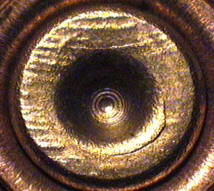
Breech marks come
in various forms. Those seen above are called parallel breech marks.
Obviously, because the marks are a series of parallel lines.
Another form of
breech marks are circular breech marks like those seen in the comparison image
below.

Breech marks can
also show no obvious pattern. They may have a stippled or mottled
appearance as seen below.
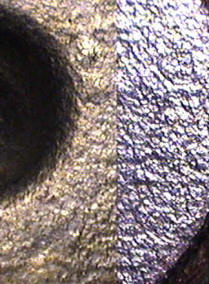
Now back to ejector
marks. Ejector marks are sometimes created when cartridges or
cartridge cases are ejected from the action of a firearm. Ejector marks
can be either striated or impressed but the impressed ejector marks not only can
be used to identify a cartridge case as having passed through a firearm's action
they can also be an indication that the cartridge case was fired in the
firearm. Ejector marks like those seen below could only be reproduced when
the cartridge cases were fired in the firearm and not by simply hand chambering
and ejecting a live cartridge.

Additional
examples of cartridge case comparisons can be seen in the image
galleries.
|